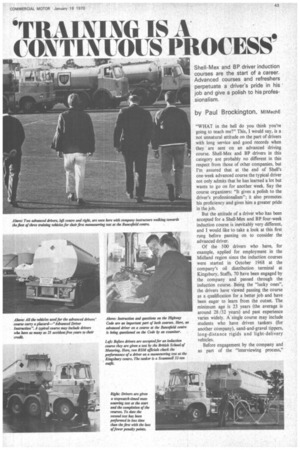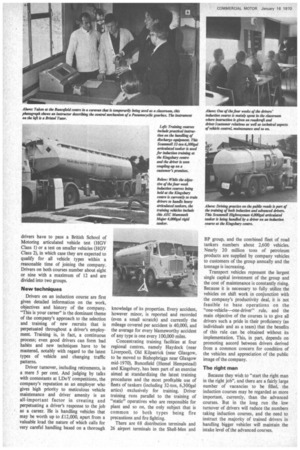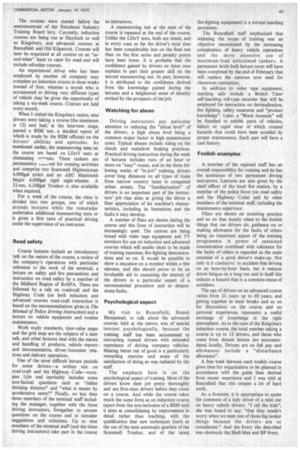*TRAINING IS A CONTINUOUS PROCESS'
Page 45

Page 46

Page 47

If you've noticed an error in this article please click here to report it so we can fix it.
Shell-Mex and BP driver induction courses are the start of a career. Advanced courses and refreshers perpetuate a driver's pride in his job and give a polish to his profes sionalism.
by Paul Brockington, MIMechE
"WHAT in the hell do you think you're going to teach me?" This, I would say, is a not unnatural attitude on the part of drivers with long service and good records when they are sent on an advanced driving course. Shell Mex and BP drivers in this category are probably no different in this respect from those of other companies, but I'm assured that at the end of Shell's one-week advanced course the typical driver not only admits that he has learned a lot but wants to go on for another week. Say the course organizers: "It gives a polish to the driver's professionalism"; it also promotes his proficiency and gives him a greater pride in thc job.
But the attitude of a driver who has been accepted for a Shell-Mex and BP four-week induction course is inevitably very different, and I would like to take a look at this first rung before passing on to consider the advanced driver.
Of the 500 drivers who have, for example, applied for employment in the Midland region since the induction courses were started in October 1968 at the company's oil distribution terminal at Kingsbury, Staffs. 70 have been engaged by the company and passed through the induction course. Being the "lucky ones", the drivers have viewed passing the course as a qualification for a better job and have been eager to learn from the outset. The minimum age is 23 years (the average is around 28 /32 years) and past experience varies widely. A single course may include students who have driven tankers (for another company), sand-and-gravel tippers, long-distance rigids and light-delivery vehicles.
Before engagement by the company and as part of the "interviewing process," drivers have to pass a British School of Motoring articulated vehicle test (HGV Class 1) or a test on smaller vehicles (HGV Class 2), in which case they are expected to qualify for all vehicle types within a reasonable time of joining the company. Drivers on both courses number about eight or nine with a maximum of 12 and are divided into two groups.
New techniques Drivers on an induction course are first given detailed information on the work, objectives and history of the company. "This is your career" is the dominant theme of the company's approach to the selection and training of new recruits that is perpetuated throughout a driver's employment. Training is, in fact, a continuous process; even good drivers can form bad habits and new techniques have to be mastered, notably with regard to the latest types of vehicle and changing traffic patterns.
Driver turnover, including retirements, is a mere 5 per cent. And judging by talks with contestants at LDoY competitions, the company's reputation as an employer who gives high priority to meticulous vehicle maintenance and driver amenity is an all-important factor in creating and perpetuating a driver's response to the job as a career. He is handling vehicles that may be worth up to £12,000, apart from a valuable load the nature of which calls for very careful handling based on a thorough knowledge of its properties. Every accident, however minor, is reported and recorded (even a small scratch) and currently the mileage covered per accident is 40,000, and the average for every blameworthy accident of any type is one every 100,000 miles.
Concentrating training facilities at four regional centres, namely Haydock (near Liverpool), Old Kilpatrick (near Glasgow, to be moved to Bishopbriggs near Glasgow mid-1970). Buncefield (Hemel Hempstead) and Kingsbury, has been part of an exercise aimed at standardizing the latest training procedures and the most profitable use of fleets of tankers (including 32-ton, 6,300gal artics) exclusively for training. Driver training runs parallel to the training of "static" operatives who are responsible for plant and so on, the only subject that is common to both types being fire precautions and fire fighting.
There are 68 distribution terminals and 26 airport terminals in the Shell-Mex and BP group, and the combined fleet of road tankers numbers about 2,600 vehicles. Nearly 20 million tons of petroleum products are supplied by company vehicles to customers of the group annually and the tonnage is increasing.
Transport vehicles represent the largest single capital investment of the group and the cost of maintenance is constantly rising. Because it is necessary to fully utilize the vehicles on shift work in conjunction with the company's productivity deal, it is not feasible to base operations on the "one-vehicle—one-driverrule, and the main objective of the courses is to give all drivers such a pride in their proficiency (as individuals and as a team) that the benefits of this rule can be obtained without its implementation. This, in part, depends on promoting accord between drivers derived from a common concern for condition of the vehicles and appreciation of the public image of the company.
The right man Because they wish to "start the right man in the right job", and there are a fairly large number of vacancies to be filled, the induction courses may be regarded as more important, currently, than the advanced courses. But in the long run the low turnover of drivers will reduce the numbers taking induction courses, and the need to instruct the majority of trained drivers in handling bigger vehicles will maintain the intake level of the advanced courses. The courses were started before the announcement of the Petroleum Industry Training Board levy. Currently, induction courses are being run at Haydock as well as Kingsbury, and advanced courses at Buncefield and Old Kilpatrick. Courses will later be organized at all centres on an "asand-when" basis to cater for need and will include refresher courses.
An experienced driver who has been employed by another oil company may complete an induction course in three weeks instead of four, whereas a recruit who is accustomed to driving very different types of vehicle may be given the opportunity of taking a six-week course. Courses are held every month.
When I visited the Kingsbury centre, nine drivers were taking a course (the maximum is 12) and had,' at the interview , stage, passed a BSM test, a detailed report of which is made by the BSM officials on the drivers' abilities and aptitudes. As mentioned earlier, the manoeuvring tests on the course are based on LDoY tests at eliminating Prs-oests. Three tankers are permanently i ved for training activities and comprise two Scammell Highwayman 4,000gal artics and an AEC Mammoth Major 4,000gal rigid eight-wheeler. A 32-ton, 6,300gal Trunker is also available when required.
For a week of the course, the class is divided into two groups, one of which attends lectures while the remainder undertakes additional manoeuvring tests or is given a first taste of practical driving under the supervision of an instructor.
Road safety Course lectures include an introductory talk on the nature of the course, a review of the company's operations with particular reference to the work of the terminal, a lecture on safety and fire precautions and instruction on road safety by a member of the Midland Region of RoSPA. These are followed by a talk on roadcraft and the Highway Code (on both induction and advanced courses road-craft instruction is based on the recommendations given in The Manual of Police Driving Instruction) and a lecture on vehicle equipment and routine maintenance.
Work study standards, time-value maps and the grid map are the subjects of a later talk, and other lectures deal with the nature and handling of products, vehicle reports and documentation, driver /customer relations and delivery operations.
One of the most difficult lecture periods for some drivers—a written test on road-craft and the Highway Code—occupies 14-hr and inevitably includes some non-factual questions such as "define thinking distance" and "what is meant by acceleration sense?" Finally, no less than three members of the terminal staff includ ing the manager. together with the three driving instructors, foregather to answer questions on the course and to consider suggestions and criticisms. Up to nine members of the terminal staff (and the three driving instructors) take part in the course as instructors.
A manoeuvring test at the start of the course is repeated at the end of the course. Unlike the LDoY tests, both are timed, and in every case so far the driver's total time has been considerably less on the final test than on the first series and penalty points have been lower. It is probable that the confidence gained by drivers on these runs explains in part their greater skill on the second manoeuvring test. In part, however, it is attributed to the confidence derived from the knowledge gained during the lectures and a heightened sense of identity evoked by the prospects of the job.
Watching for abuse Driving instructors pay paticular attention to reducing the "abuse level" of the drivers, a high abuse level being a common major factor in high maintenance costs. Typical abuses include riding on the clutch and maladroit braking practices. Practical driving instruction during the week of lectures includes runs of an hour or more on "easy" routes, and in the three following weeks of "in-job" training, drivers cover long distances on all types of route from narrow country lanes to congested urban streets. The "familiarization" of drivers is an important part of the instructors' job that aims at giving the driver a finer appreciation of his machine's characteristics, including its limitations and the faults it may develop.
A number of films are shown during the course and this form of instruction will be increasingly used. The centres are being issued with video tape equipment and TV monitors for use on induction and advanced courses which will enable shots to be made of training exercises, fire-fighting demonstrations and so on. It would be possible to show a sequence on a monitor within a few minutes, and this should prove to be an invaluable aid to sustaining the interest of the drivers in a particular aspect of a recommended procedure and to demonstrate faults.
Psychological aspect My visit to Buncefield, Hemel Hempstead, to talk about the advanced courses held at the centre, was of special interest psychologically, because the training staff has been accustomed to instructing trained drivers with extended experience of driving company vehicles. Making better out of good is a particularly rewarding exercise and some of the satisfaction of doing so was radiated by the staff The emphasis here is on the psychological aspect of training. Most of the drivers know their job pretty thoroughly and are first-class drivers before they come on a course. And while the course takes much the same form as an induction course (apart from the non-inclusion of a BSM test) it aims at consolidating by improvement in detail rather than teaching, with the qualification that new techniques (such as the use of the semi-automatic gearbox of the Scammell Trunker. and of the latest fire-fighting equipment) is a normal teaching procedure.
The Buncefield staff emphasized that widening the scope of training was an objective necessitated by the increasing complexities of heavy vehicle operations and the more extensive use of maximum-load articulated tankers. A permanent brick-built lecture room will have been completed by the end of February that will replace the caravan now used for classroom instruction.
In addition to video tape equipment, teaching aids include a Bristol Tutor self-teaching roll-type recorder that will be employed for instruction on decimalization, fire fighting, safety measures and "product knowledge". Later, a "black museum" will be founded to exhibit parts of vehicles, failure or rapid wear of which created hazards that could have been avoided by proper maintenance. Each part will have a case history.
Foolish examples A member of the regional staff has an overall responsibility for training and he has the assistance of two permanent driving instructors. Lectures are also given by the chief officer of the local fire station, by a member of the police force (on road safety and the Highway Code) and by other members of the terminal staff, including the maintenance supervisor.
Films are shown on motoring practice and so on that mainly relate to the foolish things that car drivers do, guidance on or making allowance for the faults of others being an important aspect of the training programme. A power of sustained concentration combined with tolerance for the faults of others is regarded as the main essential of a good driver's make-up. Not only is it conducive' to accident-free driving on an hour-by-hour basis, but it reduces driver fatigue on a long run and in itself this reduces a hazard that is a common cause of accidents.
The age of drivers on an advanced course varies from 23 years up to 60 years. and getting together at meal breaks and so on for discussions on the course and on personal experiences represents a useful exchange of knowledge in the right atmosphere. As in the case of the Kingsbury induction course, the total number taking a course is up to 12 drivers, and those who come from distant homes are accommodated locally. Drivers are on full pay and allowances include a "disturbance allowance".
A free week between each weekly course gives time for organization to be planned in accordance with the guide lines derived from recent experience and I was told at Buncefield that this creates a lot of hard work.
As a footnote, it is appropriate to quote the comment of a lady driver of a mini car on heavy vehicle drivers. "I tell the kids", she was heard to say. "that they needn't worry when we meet one of those big tanker things because the drivers are so considerate." And the livery she described was obviously the Shell-Mex and BP livery.
































































































